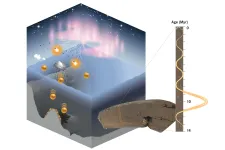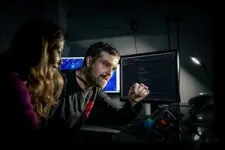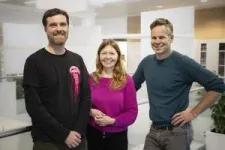(Press-News.org) Beryllium-10, a rare radioactive isotope produced by cosmic rays in the atmosphere, provides valuable insights into the Earth's geological history. A research team from the Helmholtz-Zentrum Dresden-Rossendorf (HZDR), in collaboration with the TUD Dresden University of Technology and the Australian National University (ANU), has discovered an unexpected accumulation of this isotope in samples taken from the Pacific seabed. Such an anomaly may be attributed to shifts in ocean currents or astrophysical events that occurred approximately 10 million years ago. The findings hold the potential to serve as a global time marker, representing a promising advancement in the dating of geological archives spanning millions of years. The team presents its results in the scientific journal Nature Communications (DOI: 10.1038/s41467-024-55662-4).
Radionuclides are types of atomic nuclei (isotopes) that decay into other elements over time. They are used to date archaeological and geological samples, with radiocarbon dating being one of the most well-known methods. In principle, radiocarbon dating is based on the fact that living organisms continuously absorb the radioactive isotope carbon-14 (14C) during their lifetime. Once an organism dies, the absorption ceases, and the 14C content starts to decrease through radioactive decay with a half-life of approximately 5,700 years. By comparing the ratio of unstable 14C to stable carbon-12 (12C), researchers can determine the date of the organism's death.
Archaeological finds, such as bones or remnants of wood, can be dated quite accurately in this way. “However, the radiocarbon method is limited to dating samples no more than 50,000 years old,” explains HZDR physicist Dr. Dominik Koll. “To date older samples, we need to use other isotopes, such as cosmogenic beryllium-10 (10Be).” This isotope is created when cosmic rays interact with oxygen and nitrogen in the upper atmosphere. It reaches the Earth through precipitation and can accumulate on the seabed. With a half-life of 1.4 million years, 10Be decays into boron, allowing geological dating that can extend back over 10 million years.
Conspicuous accumulation of beryllium
Some time ago, Koll's research group examined unique geological samples retrieved from the Pacific Ocean at a depth of several kilometers. The samples consisted of ferromanganese crusts, primarily composed of iron and manganese, which had formed slowly but steadily over millions of years. To date the samples, the team analyzed the 10Be content using a highly sensitive method – Accelerator Mass Spectrometry (AMS) at HZDR. In this process, the sample is chemically purified before undergoing analysis for trace isotopes. Individual atoms from the sample are accelerated by high voltage, deflected by magnets, and then registered by specialized detectors. This method allows for the precise identification of 10Be, distinguishing it from other beryllium isotopes as well as molecules and isotopes with the same mass, such as boron-10.
When the research group evaluated the collected data, they were in for a surprise. “At around 10 million years, we found almost twice as much 10Be as we had anticipated,” reports Koll. “We had stumbled upon a previously undiscovered anomaly.” To eliminate any possibility of contamination, the experts analyzed additional samples from the Pacific, which also exhibited the same anomaly. This consistency allows the team to conclude that it is indeed a real phenomenon.
Ocean currents, stellar explosion or interstellar collision?
But how did such a striking increase in concentration come about 10 million years ago? Koll, who completed his doctorate at the TU Dresden and the ANU, proposes two possible explanations. One is related to the ocean circulation near Antarctica, which is thought to have changed drastically 10 to 12 million years ago. “This could have caused 10Be to be unevenly distributed across the Earth for a period of time due to the altered ocean currents,” explains the physicist. ”As a result, 10Be could have become particularly concentrated in the Pacific Ocean.”
The second hypothesis is astrophysical in nature. It suggests that the after-effects of a near-Earth supernova could have caused cosmic radiation to become temporarily more intense 10 million years ago. Alternatively, the Earth might have temporarily lost its protective solar shield – the heliosphere – due to a collision with a dense interstellar cloud, making it more vulnerable to cosmic radiation. ”Only new measurements can indicate whether the beryllium anomaly was caused by changes in ocean currents or has astrophysical reasons,” says Koll. ”That is why we plan to analyze more samples in the future and hope that other research groups will do the same.” If the anomaly were found all over the globe, the astrophysics hypothesis would be supported. On the other hand, if it were detected only in specific regions, the explanation involving altered ocean currents would be considered more plausible.
The anomaly could be extremely useful for geological beryllium dating. When comparing different archives for dating, one fundamental problem arises. Common time markers must be identified in all data sets so they can be properly synchronized with each other. Dominik Koll explains, “For periods spanning millions of years, such cosmogenic time markers do not yet exist. However, this beryllium anomaly has the potential to serve as such a marker.”
Publication:
D. Koll, J. Lachner, S. Beutner, S. Fichter, S. Merchel, G. Rugel, Z. Slavkovská, C. Vivo-Vilches, S. Winkler, A. Wallner: A cosmogenic 10Be anomaly during the late Miocene as independent time marker for marine archives, in Nature Communications, 2025 (DOI: 10.1038/s41467-024-55662-4)
Further information:
Dr. Dominik Koll | Institute of Ion Beam Physics and Materials Research at HZDR
Phone: +49 351 260 3804 | Email: d.koll@hzdr.de
Media contact:
Simon Schmitt | Head
Communications and Media Relations at HZDR
Phone: +49 351 260 3400 | Mobile: +49 175 874 2865 | Email: s.schmitt@hzdr.de
The Helmholtz-Zentrum Dresden-Rossendorf (HZDR) performs – as an independent German research center – research in the fields of energy, health, and matter. We focus on answering the following questions:
How can energy and resources be utilized in an efficient, safe, and sustainable way?
How can malignant tumors be more precisely visualized, characterized, and more effectively treated?
How do matter and materials behave under the influence of strong fields and in smallest dimensions?
To help answer these research questions, HZDR operates large-scale facilities, which are also used by visiting researchers: the Ion Beam Center, the Dresden High Magnetic Field Laboratory and the ELBE Center for High-Power Radiation Sources.
HZDR is a member of the Helmholtz Association and has six sites (Dresden, Freiberg, Görlitz, Grenoble, Leipzig, Schenefeld near Hamburg) with almost 1,500 members of staff, of whom about 680 are scientists, including 200 Ph.D. candidates.
END
Anomaly in the deep sea
Extraordinary accumulation of rare atoms could improve geological dating methods
2025-02-10
ELSE PRESS RELEASES FROM THIS DATE:
Princeton neuroscientists crack the code of how we make decisions
2025-02-10
A new mathematical model sheds light on how the brain processes different cues, such as sights and sounds, during decision making. The findings from Princeton neuroscientists may one day improve how brain circuits go awry in neurological disorders, such as Alzheimer’s, and could help artificial brains, like Alexa or self-driving car technology, more helpful.
The findings were published February 10 in the journal Nature Neuroscience.
Walking to work, commuters encounter many sensory signals along their route, such as the glow of a crosswalk signal that indicates whether it’s safe to cross or beware of oncoming traffic. ...
Trump's 2024 election victory: A double-edged sword for the US stock market
2025-02-10
Financial markets are reacting not just to Donald Trump's return to the White House but also to the unpredictability of this victory, according to a new study from the University of Surrey. Investors must diversify their portfolios to mitigate risks associated with political volatility and to remain vigilant about the potential for abrupt market corrections.
A new study, published in Economics Letters, indicates that while there was an immediate surge in stock prices following Trump's election, this was quickly tempered by investor concerns over potential trade wars and international instability.
A group of ...
High-tech video optimization in our brain
2025-02-10
Why do our mental images stay sharp even when we are moving fast? A team of neuroscientists led by Professor Maximilian Jösch at the Institute of Science and Technology Austria (ISTA) has identified a mechanism that corrects visual distortions caused by movement in animals. The study, conducted in mice, identifies a core function that can be generalized across the vertebrate visual system, including primates such as humans. The findings are published in Nature Neuroscience.
Despite its rapid development in recent decades, the video camera industry is still catching up with the capabilities of the human eye. In particular, action cams are designed ...
Euclid discovers a stunning Einstein ring
2025-02-10
Euclid blasted off on its six-year mission to explore the dark Universe on 1 July 2023. Before the spacecraft could begin its survey, the team of scientists and engineers on Earth had to make sure everything was working properly. During this early testing phase, in September 2023, Euclid sent some images back to Earth. They were deliberately out of focus, but in one fuzzy image Euclid Archive Scientist Bruno Altieri saw a hint of a very special phenomenon and decided to take a closer look.
“I look at the data from Euclid as it comes in,” explains Bruno. “Even from that first observation, I could see it, but after Euclid made more observations of the area, ...
Biotech in Germany has significant potential, but lack of collaboration hampers growth
2025-02-10
The report “Assessing Deep-Tech Innovation Hubs in Germany: The Case of Biotechnology” evaluates Germany’s performance in deep-tech innovation within biotech using a comprehensive index and examines five key hubs: Berlin, Heidelberg, Munich, Nuremberg-Erlangen, and Stuttgart. These hubs were analyzed in terms of fundamental research, research and development in biotech, startup activity, public infrastructure, and business environment.
Berlin, Munich, and Heidelberg are the leading biotech hubs
Berlin leads the index due to its strong public infrastructure ...
Does pain affect cancer survivors’ use of non-opioid substances?
2025-02-10
Experiencing pain may increase the odds that cancer survivors will use cigarettes and cannabis, according to a recent study published by Wiley online in CANCER, a peer-reviewed journal of the American Cancer Society. The study also found that cigarette smoking and pain are linked to more treatment-related side effects and worse health among cancer survivors.
Pain and use of cigarettes, e-cigarettes, alcohol, and cannabis commonly occur together in the general population. To characterize pain in relation to such non-opioid substance ...
Scientists find that a playful approach to life activates ‘lemonading’, which helps people cope with adversity
2025-02-10
Scientists have found that taking a playful approach to life doesn’t mean you don’t take your situation seriously, but it can mean you cope with it better. By surveying people about their experiences during a Covid-19 lockdown, they learned that more playful people were more positive about the future and coped more actively and creatively. Life gave them lemons, and they made lemonade.
“Our study revealed that playfulness and resilience are intimately connected through what we call ‘lemonading’ — the ability to imagine ...
Candidate genes in canine hepatocellular carcinoma for molecular targeted therapy
2025-02-10
Unresectable canine hepatocellular carcinoma (HCC) has limited nonsurgical treatment options. Sorafenib is a targeted therapy for unresectable canine HCC. However, there are limited reports on the expression of target genes. Therefore, the efficacy of the targeted therapies for canine HCC remains unclear.
In HCC, the prognosis is generally good when complete surgical resection is possible. Unresectable nodular and diffuse HCC have a poor prognosis and limited nonsurgical treatment options. In humans, systemic therapies including ...
Opioid prescriptions in the ED linked to small increases in future opioid use, hospitalizations
2025-02-10
Opioid prescriptions in the emergency department (ED) were associated with small increases in later opioid prescriptions and hospital admissions, found new research published in CMAJ (Canadian Medical Association Journal) https://www.cmaj.ca/lookup/doi/10.1503/cmaj.241542.
To understand the relationship between opioid prescribing in the ED and subsequent harm, researchers looked at opioid prescribing at all Alberta EDs from 2010 to 2020. Of the more than 13 million visits, 689 074 patients (5.3%) filled an opioid prescription. The researchers found that opioid prescriptions did not increase the risk of ...
During pandemic, playful people were remarkably resilient, OSU research shows
2025-02-10
CORVALLIS, Ore. – Adults with high levels of playfulness showed strong resilience during the COVID-19 pandemic compared to less playful individuals, new research shows.
The study led by Xiangyou “Sharon” Shen of Oregon State University is important because playfulness is a vital but underappreciated resource for building resilience and maintaining well-being during difficult periods such as the pandemic, Shen said. And it’s a resource that individuals can cultivate.
“Understanding how playful people navigate adversity can inform interventions and strategies to help people cope with stress and uncertainty,” said Shen, an assistant professor ...
LAST 30 PRESS RELEASES:
Numbers in our sights affect how we perceive space
SIMJ announces global collaborative book project in commemoration of its 75th anniversary
Air pollution exposure and birth weight
Obstructive sleep apnea risk and mental health conditions among older adults
How talking slows eye movements behind the wheel
The Ceramic Society of Japan’s Oxoate Ceramics Research Association launches new international book project
Heart-brain connection: international study reveals the role of the vagus nerve in keeping the heart young
Researchers identify Rb1 as a predictive biomarker for a new therapeutic strategy in some breast cancers
Survey reveals ethical gaps slowing AI adoption in pediatric surgery
Stimulant ADHD medications work differently than thought
AI overestimates how smart people are, according to HSE economists
HSE researchers create genome-wide map of quadruplexes
Scientists boost cell "powerhouses" to burn more calories
Automatic label checking: The missing step in making reliable medical AI
Low daily alcohol intake linked to 50% heightened mouth cancer risk in India
American Meteorological Society announces Rick Spinrad as 2026 President-Elect
Biomass-based carbon capture spotlighted in newly released global climate webinar recording
Illuminating invisible nano pollutants: advanced bioimaging tracks the full journey of emerging nanoscale contaminants in living systems
How does age affect recovery from spinal cord injury?
Novel AI tool offers prognosis for patients with head and neck cancer
Fathers’ microplastic exposure tied to their children’s metabolic problems
Research validates laboratory model for studying high-grade serous ovarian cancer
SIR 2026 delivers transformative breakthroughs in minimally invasive medicine to improve patient care
Stem Cell Reports most downloaded papers of 2025 highlight the breadth and impact of stem cell research
Oxford-led study estimates NHS spends around 3% of its primary and secondary care budget on the health impacts of heat and cold in England
A researcher’s long quest leads to a smart composite breakthrough
Urban wild bees act as “microbial sensors” of city health.
New study finds where you live affects recovery after a hip fracture
Forecasting the impact of fully automated vehicle adoption on US road traffic injuries
Alcohol-related hospitalizations from 2016 to 2022
[Press-News.org] Anomaly in the deep seaExtraordinary accumulation of rare atoms could improve geological dating methods





